
Texas Cave.
Logistics.
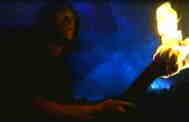
Faced with the difficult prospect of having to use the Texas Cave as both a modern and primitive location, the filmmakers had to find a way to change the caves appearance quickly and dramatically under heavy time and budgetary constraints. To accomplish this they constructed a cave on the Twentieth Century Fox back lot.
The set was framed in lumber, covered with wire mesh and plaster and then carved to give a rock-like texture.
For the scenes which took place in 35,000 BC Fiberglas walls treated to simulate ice were flown in. Chipped ice, manufactured outside the stage and carted in by crew members with wheel barrows was also used, necessitating refrigeration of the stage to between twenty-eight and thirty-two degrees.
Primitives and Aliens.
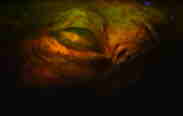
Among the scenes captured in the week long ice cave shoot was one in which two primitive men hunt out and do battle with an alien creature. Special Effects Make-Up Artist Tom Woodruff, outfitted in the foam latex suit of his own creation, played the creature. But not long into the gruelling task Woodruff found it almost impossible to perform the intricate actions of the icy set, primarily because he was blind beneath his extraterrestrial guise. Finally, he removed one of the creature’s eyes to provide a window through which he could see.
"We were shooting the scene in such low light you couldn’t tell that an eye was missing. It just looked like a black hole, which is what it looked like anyway. So we took it out." - Tom Woodruff, Special-Effects Make-Up Artist.
The Attack
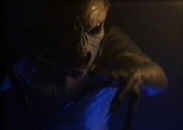
This particular fight sequence from my point of view, as a director,
was challenging because I’ve got two people in *heavy* wardrobe and
make up and I need a very physical, very violent fight in basically a black
arena and the alien, the gentleman inside the alien suit, is completely blind.
With sharp talons at the end of his fingers so I gotta protect the cavemen
from his claws and the cavemen has got to pretend to be stabbing somebody
that he can’t really stab, with his sword. And you know there’s no guns
and none of the usual things we see in a fight in the movies. So how do I
make it as real and scary as I possibly can? Well, once I saw the creature
walk in, realised that he was blind, I had to adjust the entire approach to
filming because I now needed to be very short, flashed cuts so that I could
create the illusion that the alien is quite dangerous and lethal and all the while
having this UCLA linebacker, Craig Davis and Carrick O’Quinn take all the blows.
You know, slam up against real plaster and make it as visual and dynamic
and as worthy of the opening of the movie as I possibly could. So, but none
of that was really understood until I saw (laugh) Tommy Woodruff walk on stage.
You know, sorta like a blind man walking down a sidewalk. And I thought
“Okay, I’m gonna have to be very abstract in my approach” and I think we
shot a little extra film just to have enough cuts to make it “pulse along” nicely.
It seemed to be pitfalls at every turn of how it “couldn’t” go well yet, due to
Tommy’s practices as an alien, back to the alien movies and “Punkinhead”
and Carrick’s dexterity and Craig Davis’ dexterity just being athletic. I think
we were able to pull off somewhat of a worthy fight sequence between these
two disparate characters (Rob Bowman).
The Cave Mouth.
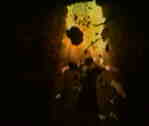
The dusty town of California City served as the caves topside, doubling for the Texas location where a young boy inadvertedly falls through in the present day.
To capture the boy’s unfortunate plunge a dummy was thrown down a fourteen foot hole dug into the hardened desert ground. The hole, lined with a Fiberglas plug, was deep enough to also allow the crew to film firemen and other rescue personnel entering the cave in subsequent scenes.
Black Blood.
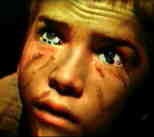
The appearance of black blood crawling worm-like beneath the boy’s skin was created through computer generated imagery and special effects photography. Having made a 3D texture map of the boy’s legs, neck and face, digital artists were able to draw and animate thin lines which would make it look like the substance was travelling up the boy’s body. To create the effect that the blood was swirling in the boy’s eyes the team photographed black liquid in a water tank and later composited it with live close-ups of the actor.
Dallas Building.
The False Facade.
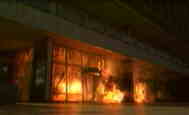
Loosely modelled on the bombing in Oklahoma City, the goal of the filmmakers in this sequence was to create the effect of an initial blast in the lower section of the building, rippling and eventually collapsing the higher levels. To accomplish this a false facade was constructed to match the architecture of an abandoned office tower in downtown Los Angeles. Made primarily of glass and aluminium, the finely detailed mask was then attached to the first and second floors of the sixteen story structure. With a little pyrotechnic wizardry the facade would be blown to smithereens, showering the movie set with debris while leaving the real building fully intact.
Fire Walls.
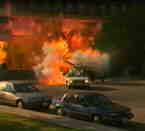
After the facade was erected and rigged with primer cord and propane, the efforts of the technical crew turned from demolition to preservation. In order to prevent the rest of the building from burning down after the blast, fire walls costing upwards of $50,000 were build out of sheet rock and positioned to contain the explosion. Refinishing by the art department again accomplished the task of disguising the construction to look like the real thing.
Models and Miniatures.
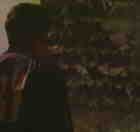
Because only two floors of the virtual building were to be blown up, model photography would then be employed in conjunction with live footage. One shot in particular, a pan of Mulder as he stands in front of the damaged building, was cleverly accomplished by placing a "green screen" in front of David Duchovny during shooting, allowing the real building to be replaced later with the miniature "bombed out" one.
Mulder and Scully Launched.
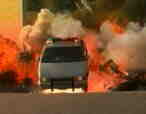
The mesmerising effect of the car carrying Mulder and Scully launching into the air as a result of the explosion was accomplished through the use of a flatbed trailer and a hydraulic lift. As the car careened forward, additional propane explosions were set off behind it. Through the limited frame of the rear window it would appear that these explosions were part of a much bigger blast. In front of the car, a rubber material was projected from small cannons and bounced off a clear plastic screen, creating the sensation of flying glass.
99.9% Success.
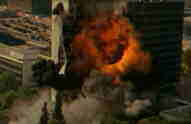
Not only did the explosion go off perfectly and without a hitch but the underlying walls of the office tower were left unmarked. There wasn't so much as a scorch mark on any of the building's real surfaces. The total damage endured by the structure consisted of a single window, the result of the concussive wave of the blast. The spectacular sequence was shot in one take and captured by fourteen live action cameras and three special effects cameras. All told, it took four to five weeks to prepare and shoot.
In Utero
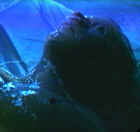
ADI...provided the cave fireman understudy by Bronschweig, which was designed to suggest a relatively early stage of alien infestation. "At that stage," explains Woodruff, "the fireman's skin has gone clear and there is a living creature embryo inside of him, moving around. You can see its eyes blinking inside the fireman's body. So, we had to create an effect within an effect: an articulated alien embryo within an articulated fireman body. The fireman body was transparent, so you could see some bone structure and some remnants of tissue and muscle underneath in the arms and legs; but all you could really see inside the torso was the alien puppet moving around."
The first step, as always, was to do a lifecast of the actor portraying the afflicted fireman - in this case, casting him from head to toe, since an entire body had to be created. That lifecast was then duplicated in clay to enable the ADI artists to resculpt, making the body appear distended in the torso area, where the alien would be, and more withered in the limbs. Moulds were then taken from the sculpture and used to run pieces of a specially formulated silicone material. "There have been some great silicones developed over the past few years," notes Woodruff. "We can make them clear, yet very soft and flexible, like flesh. We were able to control those qualities in the moulds, building up the thickness that we wanted. The thicker it is the less clear it is, so we had to be careful about that. But we wanted a certain amount of translucence, because it wouldn't have looked organic if it had been completely clear. It would have looked like an ice sculpture. We did some tests early on to determine the best thickness of skin that would be clear enough to allow us to see some of the form underneath, yet translucent enough to look real and show detail of form."
Tests were also conducted to develop a technique for adding veins and muscle tissue to the body interior. "In our tests," says Woodruff, "we actually let a layer of silicone set, then painted veins and muscle tissue on that; set another layer, and painted that, and so on, creating a real sense of depth in the vein networks. But when we actually got to building the bodies, we changed to a simpler technique. We built a core that represented the internal structure of the body - a little bit of bone and muscle - and we painted veins right on that core. So the bones and the muscle and all of that stuff you see inside the fireman is really just a one-piece structure. The clear silicone skin went over that, and was painted with an additional surface coating of veins." Final stages of building the fireman body included putting in acrylic eyes and teeth, then punching real human hair into the into the head and body, one hair at a time. "That made it dead on real looking, as if the hair was actually growing out of this translucent skin."
For the alien embryo inside the fireman's body. ADI created a sculpture, from which the final foam latex creature was made. Like the full-size aliens, the embryo had an articulated head, operated via radio control. "He was capable of blinking and opening his jaw," said Woodruff. "Then, for more general body movements, we put little rods coming out from his backside, so puppeteers could get back there and move him around a little bit. He was sculpted in a foetal position; but he was able to move his shoulders and scootch around as if he was trying to make himself comfortable." A window cut into the core in the back of the fireman body gave puppeteers access to the puppet rods. "Everybody was thrilled with the embryo and the cave fireman when we got to shooting it. The fireman was lying there with his eyes open, his head rolling around, and his jaw opening as if he was taking his last breath. Inside the chest, you could see his lungs expanding and his heart pumping and a vein throbbing in his neck as the embryo brought its face up to the transparent skin of the torso. The embryo blinked and moved its hands and jaws. It was very effective. Out of everything we did on the show, that was the effect that elicited the most startled response from everybody on the set. They were amazed."
Cornfield & Bees.
Domes and Lighting.

Thirty feet high, ninety feet wide and one hundred forty feet long, the two bee domes erected by the art department were inflatable and translucent. Lit from inside they resembled giant Christmas ornaments. But interior lighting was the least of director of photography Ward Russell's concerns. Of a more serious nature was the problem of lighting the field itself, an eight acre area in which Scully and Mulder were to be chased by syndicate helicopters. Russell's solution: Two xenon lights mounted on the bottom of the choppers like search lights, which also worked well for the scene itself. And to ensure that the black air-ships would show up in the night sky white stripes were painted on the rotor blades, creating the illusion of whizzing white circles appearing above.
Stresses.
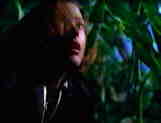
Among the numerous reasons the sequence was tedious and difficult to shoot was the question of safety. Aerial co-ordinator Dave Paris had to carefully orchestrate the action to ensure that actors, pilots and ground crew were not in danger while still affording the choppers low enough altitude to be seen in the frame. Equally taxing was the vast amount of smoke that needed to be generated over the three to four day period. When photographing the wide shots, stunt doubles were used for Duchovny and Anderson. But for closer shots the stars were needed to step in, each inhaling their share of dust and smoke as well as suffering cuts and abrasions from the slashing cornstalks.
Trained Bees.
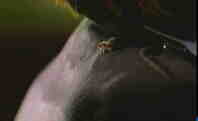
Possibly the trickiest shot in the film occurred during Scully's appearance before the review board. In the scene, a bee was to crawl out from her collar, walk a few steps, then disappear again. Entomologist and film industry bee wrangler, Dr. Norman Gary expressed his reservations about a single bee being able to pull off such a complex and detailed behaviour. Several sleepless nights later, Gary devised an ingenious plan to influence his insect prodigy by treating the fabric of Scully's coat with a pheromone attractant he'd developed.
"The bee came out of the cage, sensed the pheromone trail, turned toward it, and walked slowly across the back of the collar...just like it was supposed to do. That little bee repeated this behaviour about a dozen times that morning, flawlessly. Everybody on the set was astounded. And frankly, I was just as astounded...To me that bee was like Trigger to Roy Rogers." - Dr. Norman Gary, Entomologist, Bee Wrangler.
Antarctica.
The Ice Station.
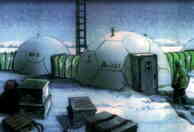
Designed in modules, the ice station set was constructed in Los Angeles and then airlifted to the British Columbia glacier where the Antarctic scenes were to be shot. Low visibility and threatening weather however, prevented the helicopters from locating the site, stranding the construction crew with insufficient supplies and equipment. Fortunately, only two days passed before the cloud cover lifted and the assembly, which consisted of five Fiberglas domes each twenty feet in diameter, was finally completed.
"We were stuck there for almost two full days, so we had to spend one night there, with nothing but our sleeping bags. Since the ice station was a solid, practical structure, we kept building through the storm, and used the set as shelter that night. It was a good thing we'd done that, because we woke up to about six inches of fresh snow the next morning." - Marc Fisichella, Art Director.
The Spaceship.

Design of the spaceship presented an interesting quandary for production designer Chris Nowak; neither Mulder nor the audience would be aware that this cavernous space was indeed the interior of an alien spacecraft until later in the final sequence. In light of this, Nowak and his team settled on the mysterious, claustrophobic feel of a huge tubular structure, inside which would be a series of long corridors lined with embryonic cryopods. Construction of the set, which was made up of layers of plaster, foam and styrene, consumed every inch of the massive soundstage. Nowak's crews worked around the clock, sixty days straight without a break, to complete it in time.
Cryopods.
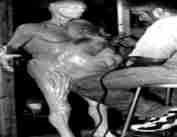
Two mechanically articulated host bodies were built in which aliens would begin hatching and breaking free of the cryopods. Both were made of transparent silicone, supported by a core that represented what little was left of the host's internal organs and bone structure. Facial articulation in the creature's head was radio controlled from off-camera. Gross body movement as the alien struggled to be born was accomplished by puppeteers hiding behind the cryopods and manipulating the creature's manually.
"The alien inside uses the host's proteins and organs to feed itself. So as the embryo grows, the body withers and becomes nothing but a husk." - Alec Gillis, Special Effects Make Up-Artist.
Ice Breaker.
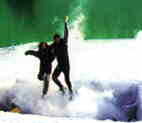
The spectacular climax of the film was created using shots of the spaceship built on stage, a tabletop miniature and model spaceship, and live footage taken at the glacier. On stage, Duchovny and Anderson ran through geysers of steam rigged by the special effects crew. This "green screen" footage" was then composited with wider shots of the miniature ice blanket imploding and the model spaceship rising. The sixty-by-twenty-foot miniature glacier featured sections that could be pulled out in sequence, creating collapsible areas of fake ice, baking soda, salt and stearic acid; materials mixed to simulate a powdery top layer of snow.
Most of the information and pictures on this page were taken from the Foxhome X-Files Movie Site.The information was originally taken from 'The Making of The X-Files.' by Jody Duncan which I heartily recommend.
The section entitled "In Utero" (sorry I couldn't resist the Nirvana reference) was typed by me from 'The Making of The X-Files.' by Jody Duncan.
The section entitled "The Attack" is taken from The X-Files Movie DVD Commentary transcribed by Donna with help from
MJames5180@aol.com.
BACK



















